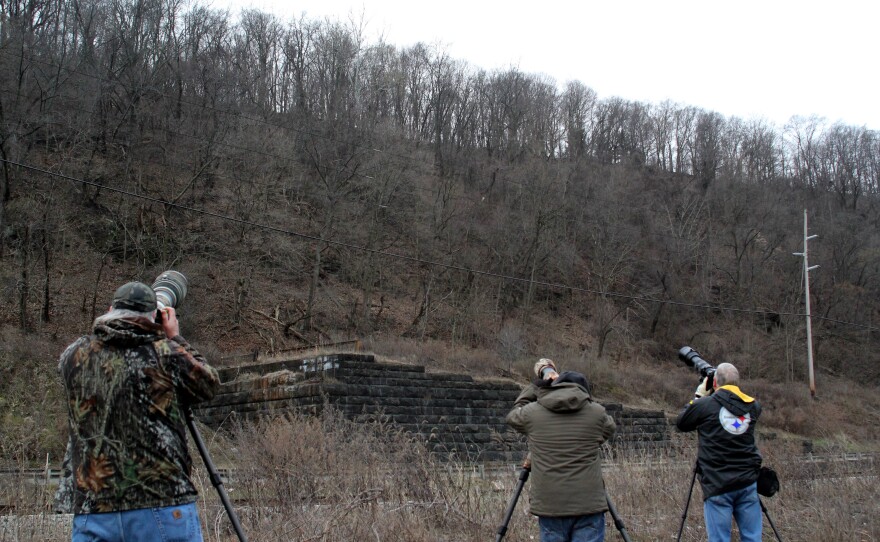People who started as strangers have become friends, spending every weekend on a portion of the Great Allegheny Passage trail, gazing upward.
They watch a pair of bald eagles nesting 6 miles from downtown Pittsburgh. They bring lawn chairs and telephoto camera lenses. Some wear binoculars; others are clad in camouflage waiting for the birds to fly overhead to the Monongahela River to hunt for fish.
Often, joggers and cyclists stop and ask what the group is looking at.
That’s when they show off their knowledge. They tell them how the male and female eagles switch off egg guarding duty, what kind of fish the birds bring back to the nest, how they roll the eggs to keep a steady temperature and that the nest is the size of a queen mattress.
“They’re killing machines,” said Dan Dasynich. “That’s all they do is reproduce and kill. That’s all they’re meant to be.”
Daysnich watched a live video stream of the eagles in the nest on his phone, while waiting behind his camera for the birds to fly.
The webcam brings most of the bird watchers to the trail.
The Audubon Society of Western Pennsylvania got a permit from the Pennsylvania Game Commission to install a camera for educational purposes in 2014 after a pair of eagles nested in Hays.
Jim Bonner, the Audubon Society’s Executive Director, said, until that year, eagles hadn’t nested in the region since before records were kept. Some researchers think that could be as long as 200 years.
The birds couldn’t survive in Pittsburgh because of a lack of their main food source – fish.
Unregulated industrial pollution made the rivers inhabitable for fish. Bonner said when he was growing up in the area, the rivers were essentially an extension of the sewage system. Daysnich said the same thing.
But with pollution regulation, the rivers have cleaned up. Dasynich said in the last few years he’s caught more than 20 species in the river. He doesn’t eat them. But they’re there.
The eagle couple in 2013 was able to successfully hatch, fledge and teach to fly one eaglet. The next year, a pair of eagles fledged three chicks successfully. In 2015, two eggs were laid but neither survived. Bonner said that can be attributed to an unusually cold winter.
Bonner said it's unclear if the adult eagles are the same pair every year, because eagles are no longer banded and tracked in Pennsylvania. But once the young are able to fly on their own, they are seen as competition and leave the area.
Eagles are no longer an endangered species. They aren’t even at the threatened level.
“We’re very familiar that DDT caused problems with eggs that made them very soft," Bonner said. "So when they tried to lay on them, they would crush them. And they were almost completely wiped out in this part of the country."
DDT was a pesticide used in agricultural practice that seeped into ground water and eventually infected rivers and fish.
One of the people who helped bring the danger of DDT to the country’s attention was Rachel Carson with her book Silent Spring. She was a well-known conservationist from the Pittsburgh suburb of Springdale, who studied at what is now Chatham University.
The hometown name, combined with river cleanup, has led to quite the eagle following.
At any given time, hundreds, if not thousands, of eyes are on the eagles through the webcam. There’s also a live chat function so viewers try to update each other on the patterns of the birds.
“It’s become its own citizens science project, we think of it as kind of crowd-sourcing for the eagles. And all those are important,” Bonner said. “Although there are now a few other eagle and nest cameras out there, this is still rather new. And we’re collecting a lot of information that we would previously not be able to do.”
On the Saturday the first eaglet of 2016 was expected to hatch, avid webcam watcher Wendy Merrill showed up. Daysnich hugged her and the two chatted about the birds. They, like most of the people on the trail, met because of the eagles.
Merrill is a clinical psychologist. She said she enjoys studying their social patterns.
“It wasn’t very long ago that the only people who got to see inside an eagle’s nest were an elite, small group of researchers,” she said.
So far, two eaglets have hatched in the Hays nest. There are two other nests in the region, one on private property in Crescent and another in Harmar. The Harmar nest also has a live webcam.
Viewers have watched two eaglets break out of their shells so far. The eggs were laid a few days apart and have hatched accordingly.






